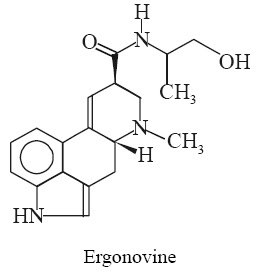A. Ergonovine
Synonyms Ergometrine; Ergobasine; Ergotocine; Ergostetrine; Ergotrate; Ergoklinine; Syntometrine.
Biological Sources It is obtained from the seeds of Ipomea violaceae Linn. (Ipomea tricolor Cav.) belonging to family Convolvulaceae (Morning glory, Tlitliltzen, Ololiuqui); and also from the dried seeds of Rivea corymposa Hall. F. (Convolvulaceae) (Snakeplant).
The percentage of Ergometrine and Ergine present in the Rivea and Ipomea species are as given below:
Chemical Structure
[8β (s)]-9, 10-Diadehydro-N-(2-hydroxy-1-methylethyl)-6-methylergoline-8-carboxamide; (C19H23N3O2).
Isolation The following steps may be followed stepwise:
1. The seeds are dried, powdered, sieved and finally defatted with n-hexane in a Soxhlet apparatus.
2. The defatted mare is extracted with hot dilute sulphuric acid (6N) successively. The acid extract is then treated with on excess of barium sulphate, and the barium is removed with CO2 and subsequent filtration.
3. The resulting filtrate is then concentrated by evaporation under reduced pressure.
4. The concentrated solution is taken up in ethanol, made alkaline with NH4OH and subjected to extraction with chloroform successively.
5. The resulting chloroform extract is further extracted with dilute H2SO4 (6N). The acidic solution is made alkaline with ammonia and saturated with NaCl and then extracted with ether several times.
6. The solvent is removed from the ether extract under vacuo leaving the alkaloidal residue.
7. Ergonovine may be recrystallized from acetone.
It may also be prepared from D-lysergic acid and L (+)-2-amino-1-propanol by the method of Stoll and Hofmann.*
Characteristic Features
1. Ergonovine is obtained as tetrahedral crystals from ethyl acetate, and as fine needles from benzene. It tends to form solvated crystals having mp 162°C.
2. It has specific optical rotation [α]20D + 90° (in water).
3. Its dissociation constant is pKa 6.8.
4. It is found to be freely soluble in lower alcohols, acetone and ethyl acetate; more soluble in water than the other principal alkaloids of ergot; and slightly soluble in chloroform.
Identification Tests As per se the ergot alkaloids may be identified either by general precipitation and colour reactions or by preparing their derivatives as stated below:
(a) Precipitation Reactions
(i) The ergot alkaloids are readily precipitated by the alkaloidal reagents. However, Mayers reagent is regarded to be the most sensitive test whereby on opalescence in dilutions of 1 ppm can be obtained.
(ii) Iodine solution in KI also gives an instant precipitate with very dilute solutions of ergot alkaloids.
(b) Colour Tests: The most vital colour tests are given as under:
(i) Keller's Test: To a solution of the alkaloid in glacial acetic acid add a few mg of solid FeCl3 and then add 1-2 ml of concentrated sulphuric acid along the side of the tube. The appearance of an intense blue colouration is accomplished at the junction of the two layers.
(ii) Van Urk Test: When a solution containing an ergot alkaloid is mixed with Van Urk Reagent**, it gives rise to a characteristic deep blue colouration.
Note: (a) Van Urk Reagent may also be used in spraying developed paper chromatograms of the ergot alkaloids, and for this purpose 10% (v/v) HCl is used instead of H2SO4.
(b) The spectrophotometric assay for total ergot alkaloids is also based on the blue colour given with Van Urk Reagent.
(iii) Glyoxylic Acid Reagent Test: Ergot alkaloids gives a blue colouration with the addition of Glyoxylic acid reagent and a few drops of concentrated H2SO4.
(iv) Fluorescence Test: The aqueous solution of the salts of ergot alkaloids produce a distinct blue fluorescence.
(c) Derivatives of Ergonovine: The various derivatives of ergonovine are as follows:
(i) Ergonovine Maleate (Ergometrine Maleate) (C19H23N2O2.C4H4O4) [Synonyms Cornocentin; Ermetrine; Ergotrate Maleate]: It is obtained as crystals that decompose at 167°C. It has specific optical rotation [α]25D + 48° to + 57°. 1g dissolves in 36 ml water and 120 ml ethanol. It is almost insoluble in chloroform and ether.
(ii) Methylergonovine Maleate (C20H25N2O2.C4H4O4): It is a semisynthetic homologne of ergonovine and prepared from lysergic acid and 2-aminobutanol. It is obtained as a white to pinkish-tan microcrystalline powder.
(iii) Ergonovine Tartrate Hydrate (Ergometrine Tartrate Hydrate) [(C19H23N3O2)2. C4H6O6.H2O] (Basergin, Neofermergen): It is obtained as crystals that are slightly soluble in water.
Uses
1. Ergonovine is used as an oxytocic.
2. Ergonovine maleate also acts as an oxytocic and produces much faster stimulation of the uterine muscles as compared to other ergot alkaloids.
3. Methylergonovine meleate is observed to act as an oxytocic whose actions are slightly more active and longer acting than ergonovine.
-----------------------------------------------
* Stoll, A., and Hofmann, A., Helv. Chim Acta, 26, 944 (1943).
** Van Urk Reagent Mix togetehr 0.125g of para-dimethylamino. benzaldehyde; 0.1 ml of FeCl3 soln. (5% w/v),
and 15% (v/v) H2SO4 to make 100 ml.
Source:Pharmacognosy And Pharmacobiotechnology By Ashutosh Kar
Source:Pharmacognosy And Pharmacobiotechnology By Ashutosh Kar




0 Comment:
Post a Comment